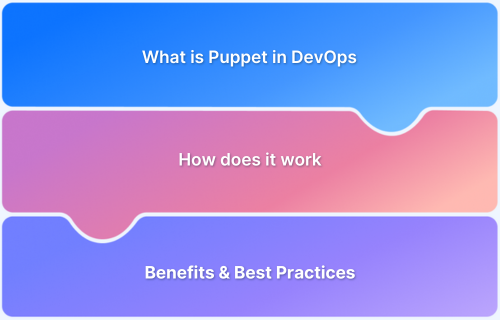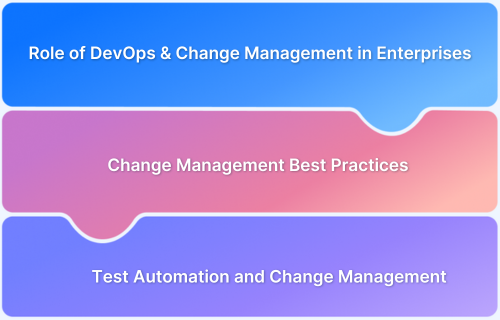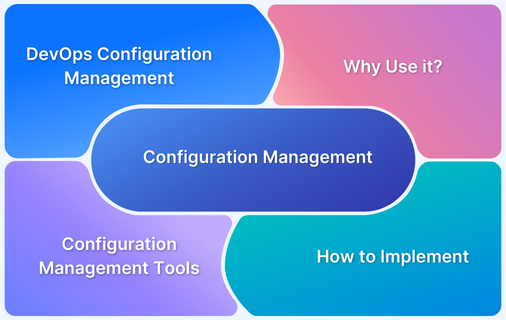What is Configuration Management in Software Testing
By Tom Collins, Community Contributor - December 17, 2024
Configuration management (CM) is the process of managing and maintaining the settings and components of IT systems, including software, hardware, and networks. It ensures systems stay consistent, reliable, and aligned with desired outcomes.
In software development, CM involves version control and CI/CD pipelines to track and manage changes effectively.
This article will explain the key concepts of configuration management and its importance in maintaining system stability and reducing errors.
- What is Configuration Management?
- Importance of configuration management in software testing
- Working process of configuration management
- Understanding Configuration management in DevOps, CI/CD, and Agile
- Configuration Management in DevOps
- Configuration Management in CI/CD
- Configuration Management in Agile
What is Configuration Management?
Configuration Management (CM) is a process for managing and controlling changes to a software product throughout its lifecycle. It ensures that updates are tracked, implemented, and monitored to maintain system integrity and reduce errors.
As software development progresses, frequent updates and changes create numerous components called Software Configuration Items (SCIs).
Configuration Management manages these by:
- Tracking and documenting changes.
- Reviewing and implementing modifications.
- Auditing to ensure consistency and compliance.
It productivity, minimizes errors, and supports evolving requirements, making it essential for a collaborative and dynamic development environment.
Importance of configuration management in software testing
Here are some reasons why you need configuration management:
- It supports tracking the changes in your system. Thus it brings down the risk of system outages and cyber-security issues like data breaches and leakages.
- Configuration management and version control together solve the problem of unexpected breakages due to configuration changes. How? They provide visibility to those modifications. The version control system can track the changes that permit the development team to review them. Also, it enables ‘undo’ functionalities for configuration that creates barriers for breakages.
- It helps to improve the user experience through quick detection and solution for improper configurations. Thus it decreases the negative reviews of products.
- Reduce the cost of your technology asset by eliminating configuration redundancy because it keeps detailed knowledge of all the configuration elements. In this way, it also saves valuable time and effort.
- You can control your process by implying definitions and policies of identification, updates, status monitoring, and auditing.
- You can replicate an environment precisely with the help of configuration management. In this way, the production and test environment remain the same. Thus it reduces performance issues.
Working process of configuration management
Following is a detailed overview of the working process of configuration management –
- Identification: This is the first step of configuration management. You have to gather information from several applications, environments, development, and staging for all elements and services. Sensitive data like passwords and keys should be identified and securely encrypted, and stored in a safe place. It organizes configuration info within files, and those files would be a trustworthy source of data. The configuration management databases (CMDBs) give a good result for this purpose.
- Baseline: After organizing the configuration data, you need to establish the baseline. The baseline of configuration helps to work software without any error. This aims for a centralized modification of baseline configuration. You have to set a baseline after reviewing and committing to the design of the running production environment.
- Version control: It’s the third step performed after the baseline configuration. In this step, your organization should put the project within a version control system like Git. Then you need to add configuration data files within the repository, including the changes. These changes will automatically adapt to the original environment. But be careful that you shouldn’t include any security data like passwords and keys to the repository.
- Auditing: The configuration will be visible after adding the configuration data within a version control system. Again, it enables collaboration like pull request workflow so developers can review and edit codes. Ultimately, it will help to process an audit that checks whether the software meets requirement specifications. The team must accept any changes in the configuration after reviewing them.
Understanding Configuration management in DevOps, CI/CD, and Agile
Configuration management is crucial in DevOps, CI/CD, and Agile methodologies by automating and standardizing system configurations across development and deployment environments. It ensures consistency, accelerates deployment pipelines, and minimizes errors during iterative changes.
Before diving into configuration management in these practices, it’s essential to understand the differences between Continuous Integration (CI) and Continuous Delivery/Deployment (CD), as well as the distinction between Agile and DevOps approaches.
Configuration Management in DevOps
DevOps configuration management promotes the speed, accuracy, and efficiency of the system. It saves developers’ time and automates maintenance tasks. A successful DevOps configuration has two results- Infrastructure-as-a-code (IaaC) and Configuration-as-a-code (CaaC).
IaaC brings up the code that automates the preparation of the environment for development and testing tasks. Later you have to put the code in the version control system as usual.
CaaC states the configuration of servers, networks, data files, hardware, and other computing resources. As for IaaC, you have to put the code again in the version control system for CaaC. This will help to run the software as predicted.
Read More: What is DevOps Configuration management
Configuration Management in CI/CD
The CI/CD configuration management records the details of a distinct infrastructure. Later, it will help to identify the changes made in the setting. With the aid of the CI/CD pipeline, you will get several environments for testing and staging your product before release.
You need to replicate the pre-production environment for the pipeline and testing. Then you can accelerate the CI/CD configuration by storing the data in a structured format like- XML or YAML file. Again, it will be easy to set your pipeline for refreshing the environment between deployments, if you use an IaaC approach.
Configuration Management in Agile
Agile configuration management has several features like updating production SSL certificates, adding new DB endpoints, password changes, and API keys for new third-party integration. The important thing is that agile necessities automation for the CM. Thus development in agile becomes faster than traditional manual processes. It removes the bottlenecks and gives time to focus on more growth.
Tools for Configuration management
Configuration management tools are essential for automating the setup, monitoring, and management of system configurations. They ensure consistency, reduce errors, and streamline the process of handling changes in complex environments.
Here are some widely used tools:
1. Ansible
It’s the leader in the market of CM tools. Currently, it has a 24.5% share of the market. It’s an open-source system to automate IT infrastructures and environments. It’s written in Python, which makes it easy to learn. There are playbooks-YAML-based configuration files in Ansible. They support comments, and anchors to refer to other items.
2. HashiCorp Terraform
It has a 20.27% market share just after Ansible. It mainly focuses on server authorization rather than configuration. It makes all the servers synced regularly to eliminate the configuration drifts.
3. Puppet
It uses a Master-agent architecture to store resources in an expected state. It uses Ruby domain-specific languages for CM. You can run Puppet multiple times and make changes to your system’s state until you can’t match it with the desired state. This is called the Idempotence principle.
4. Salt Stack
SaltStack is a powerful configuration management and orchestration tool designed to automate IT tasks and reduce manual errors. It centralizes the provisioning of servers, management of infrastructure changes, and software installations across physical, virtual, and cloud environments.
Salt is widely used in DevOps, integrating with repositories like GitHub to distribute code and configurations remotely. Users can also create custom scripts or use prebuilt configurations, boosting flexibility and collaboration.
5. Chef
Chef is a robust automation platform that simplifies infrastructure management by converting configurations into code. It enables seamless deployment, updates, and management across environments, supporting infrastructure as code (IaC) principles for scalability and consistency.
6. CFEngine
CFEngine is a lightweight and scalable tool for automating system management tasks. It excels in configuring, monitoring, and maintaining large-scale infrastructures, with a focus on security and performance.
7. Rudder
Rudder combines configuration management with continuous compliance. It offers a web-based interface for real-time monitoring and configuration, ensuring systems adhere to security and operational standards.
8. Otter
Otter automates infrastructure management by providing a visual interface to define and enforce desired states for servers. It integrates well with CI/CD pipelines and simplifies repetitive tasks in DevOps workflows.
9. Juju
Juju focuses on deploying and managing applications in cloud environments. It uses reusable, customizable configurations called “charms” to simplify the deployment and scaling of complex software stacks.
10. Kubernetes ConfigMaps
Kubernetes ConfigMaps allow you to decouple configuration data from application code in containerized environments. They make it easy to manage environment-specific settings without rebuilding application images, improving flexibility and maintainability.
Configuration Management on Real Device Cloud with BrowserStack
BrowserStack helps you in configuration management with its real device cloud. There you can perform both manual and automation testing. But we discussed earlier that automation is the best solution for CM. For executing automation tests on real devices, you can prefer App Automate and Automate for Mobile and Web Apps respectively. They have features like Cloud Selenium grid, CI/CD integrations, test management, and report abilities.
Advantages of Configuration Management
Below are some advantages of Configuration Management in software testing:
- Enhanced Productivity: Streamlines the process of managing changes, saving time and effort for development teams.
- Error Reduction: Minimizes the risk of defects by ensuring thorough testing and validation of all modifications.
- Improved Collaboration: Provides a centralized repository for artifacts, fostering better communication among team members.
- Higher Software Quality: Maintains system stability by enforcing strict control and monitoring of changes.
- Efficient Tracking: Offers clear visibility into changes, helping teams monitor progress and maintain consistency.
Disadvantages of Configuration Management
Below are some key limitations of Configuration Management:
- Increased Complexity: Can add complexity and overhead, especially in large or complex software systems.
- Dependency Management Challenges: Difficult to manage and integrate dependencies effectively across various components.
- Potential for Conflicts: Large development teams with multiple contributors may experience conflicts and delays in coordination.
- Resource Intensive: Requires dedicated resources and infrastructure to maintain proper configuration control and automation.
Best Practices for Configuration Management
Below are some key practices for Configuration management in software testing:
- Automate Processes to streamline tasks and reduce errors.
- Use Version Control for all configuration files and scripts to track changes and maintain a history.
- Maintain Documentation for clear communication and easier troubleshooting.
- Regular Audits to ensure configurations meet security and compliance standards.
- Test Configurations in staging before deploying to production.
- Monitor and Track Changes to ensure all modifications are properly implemented.
Future Scope of Configuration Management
Successful configuration management aims to identify all code, easily retrieve all configuration items, good configuration audit, desired state, accumulation of change requests without any regression, and more. The CM tools support changes and improvements in the CM environment. In the future, the CM will include tools like Kubernetes, Docker, Habitat, etc. These tools will capture the market from virtual machine-based deployment.
Configuration management is necessary for extensive software systems. Without the CM your system may be compromised with unexpected outages, implementation failure, and lack productivity, reliability, and scalability. So learn more about this technique with BrowserStack. It has 3000+ real devices and browsers for testing your web and apps in real user conditions from home.
Conclusion
Configuration management is essential for maintaining consistency, reducing errors, and improving efficiency throughout the software development lifecycle. By systematically managing changes, tracking dependencies, and automating tasks, organizations can ensure stable, scalable, and high-quality systems.
Whether in DevOps, CI/CD, or Agile environments, effective configuration management is key to delivering reliable and secure software while meeting evolving requirements.




